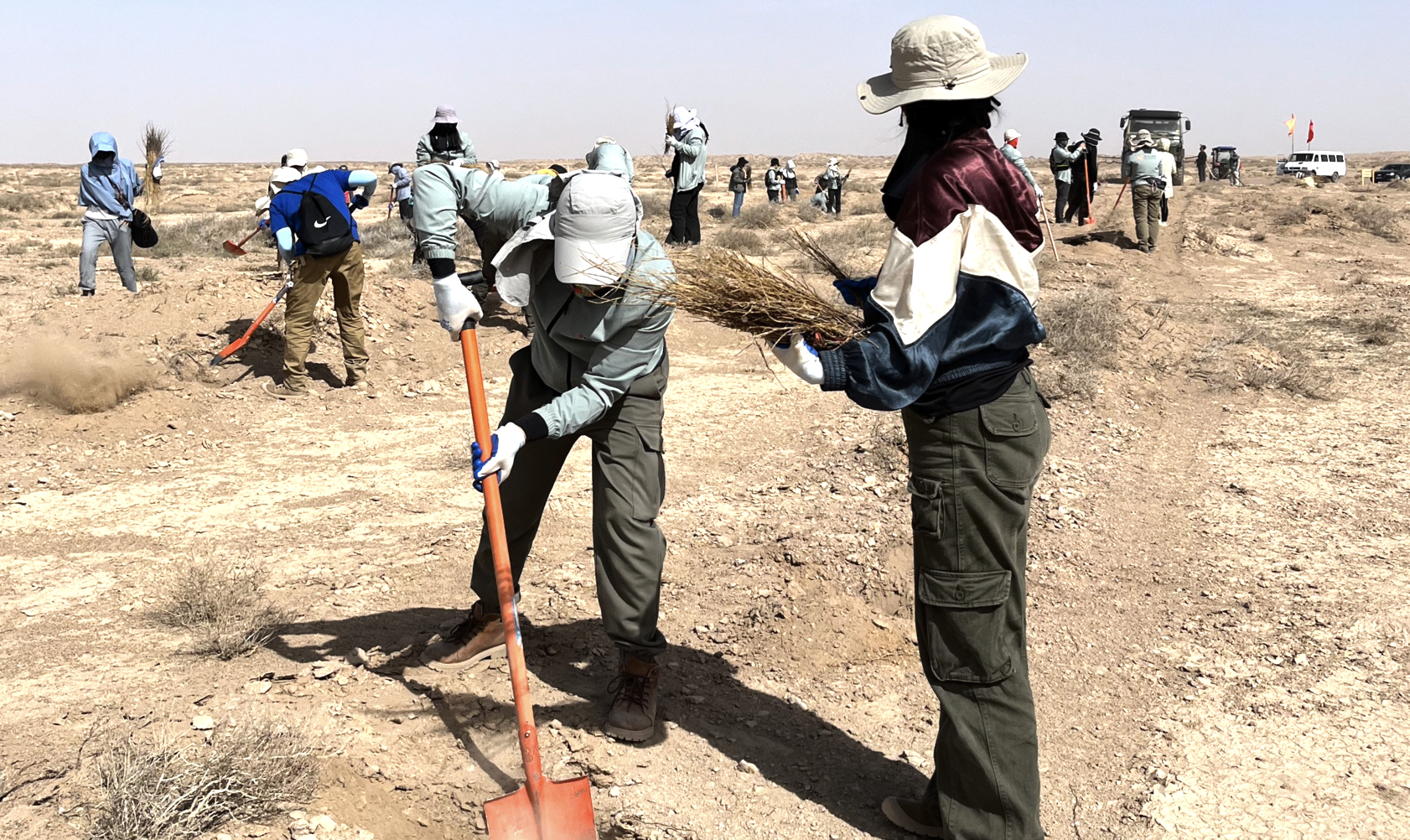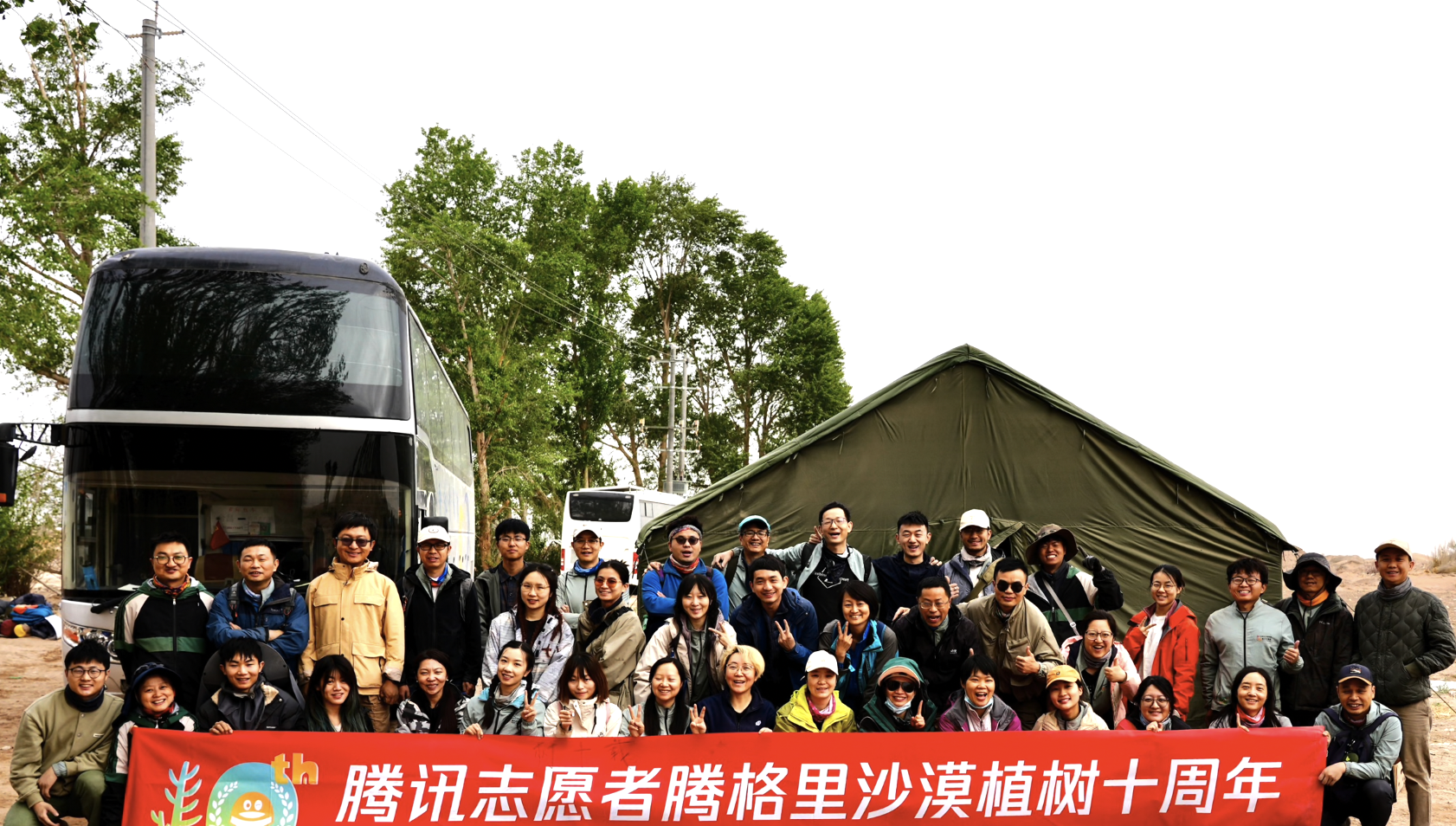Planting Seeds of Change: How Tencent is Combating Desertification
This year marks the 10th anniversary of the Tengger Desert Tree Planting project by Tencent Volunteers. Since 2013, more than 300 Tencent employees have volunteered to travel to the remote Tengger Desert in northwestern China to plant trees to stop the desert from encroaching on what little arable land exists there.
Their efforts have seen more than 600 acres, or the equivalent of over 300 football fields covered in hardy Haloxylon, or saxaul trees, with a remarkable 85 percent survival rate of saplings.
This project not only showcases Tencent’s commitment to environmental protection and social good. It has also been a valuable team bonding exercise, taking volunteers on a rewarding journey of camaraderie and self-discovery along the way.
Below is an edited extract of a daily journal kept by one of the volunteers. It is a personal account of how the project works in action and the highs and lows, challenges and rewards that come with such an ambitious initiative.
Day 1: Strangers Gather in the Desert
Each year, a group of Tencent employees journeys to China’s northwest to plant trees in the Tengger Desert, a faraway but ecologically important area.
A group of 40 gathered from across China to fly from Lanzhou airport to Tenggar Desert, where we will be camping. Once there, it was straight down to business.
Two local teachers shared the history of the region and today’s challenges. They told us about the principles of sand control and the importance of saxaul trees, which are drought-resistant, work as shelter belts, help stabilize sand dunes and store water. We learned that the fruits of previous efforts can already be seen, with some small wildlife returning to the desert.
Equipped with shovels and gloves, we dig pits, which have been carefully marked out, plant seedlings, and water the trees. Despite the scorching sun, we work hard, regularly reviewing to ensure everything is done correctly to maximize the survival of the saplings.
 The volunteers are planting trees at the designated locations.
The volunteers are planting trees at the designated locations.
Day 2: Sandstorms, Cleaning and Rebuilding
Overnight – disaster! A powerful sandstorm swept through the camp, damaging tents and covering the site in sand. Howling wind prevented some of us from sleeping. When day broke, we worked to clear the sand and repair tents. Breakfast was prepared with limited resources, and demonstrated the volunteers’ resilience and creativity.
To get through, we shared stories and found a sense of community in the desert. Watering the freshly dug tree pits became a therapeutic experience, with volunteers focusing on each pit’s transformation and nurturing tree growth. There is an art and science to watering plants that can only be learned by doing it. After the storm, the need to combat desertification became even clearer, making us more determined to create a greener future.
Day 3: Finding Rhythm
As the tree planting continued, the physical toll of 12-hour work days became evident. Fatigue, sunburn and minor injuries occurred, but with support and encouragement, we pushed forward, finding our own rhythm to focus on quality work. Faced with the daunting prospect of two more days of round-the-clock planting under the scorching sun, endurance became a test and we dreamed of our next shower.
Day 4: Witnessing the Result of Past Efforts
Once again, howling winds overnight disrupted our sleep and forced many of us to move to the large communal tent. We waited for the wind to subside, but it persisted throughout much of the next day, causing us to change our plans. It was another reminder of the power of nature in the desert.
Although the idea of losing another day of planting was frustrating, we found other ways to make the most of our precious time, gathering in the big communal tent to get to know each other better. Common traits united us: caring, action-oriented, hungry for knowledge and energetic.
When the wind subsided in the afternoon, we visited the “Tencent Forest” of camps and woodlands where previous volunteers had planted trees. The once barren land had transformed into a thriving forest. Veteran volunteers could see how the trees had slowly grown. Sitting on the sandy slope, we felt a deep connection with those who came before us.
Day 5: The Fruits of Our Labor
On our last full day’s afternoon, we visited Sifang Pier, a historic landmark dating back thousands of years to the Han Dynasty, which used to be a long way from the planting site. The edge of the forest has expanded to be closer to it, and we were able to walk over to the pier.
We climbed the pier, which boasted panoramic views of the desert, and it allowed us to see how tall the oldest trees had grown and how much progress has been made. Visiting Sifang Pier and the place where the first tree was planted in 2013 brought a real sense of accomplishment and awe.
As we bid farewell to the desert, we reflect on the past decade and the growth of our volunteer team. The memories and achievements will forever be preserved in the trees and fallen tree trunks. With the spirit of Tencent driving us, we leave the desert with a sense of pride and hope for the future.
During our final meeting, we shared love and beauty in the intensity and peace that coexisted in the desert. We let go of the past, embraced the present and looked forward to the future.
 A group photo of the Tencent volunteers.
A group photo of the Tencent volunteers.
Day 6: Farewells and Memories to Last a Lifetime
We packed up our belongings, clean the camp and say our goodbyes with a mix of reluctance and sadness.
We came as volunteers but leave as friends, 40 individuals from across the country who joined hands to plant 10,000 trees in the Tengger Desert and leave small seeds of change in the vast desert.
As we return to our own lives, we carry our stories and growth with us. The bonds we formed with our teammates, the moments of shared experiences and the memories we created will remain with us. The seeds we planted, both literal and metaphorical, will continue to thrive within us.


